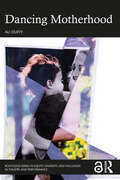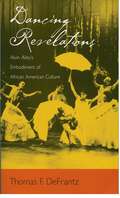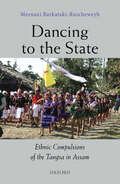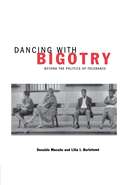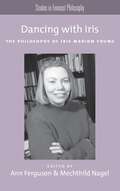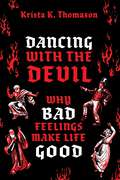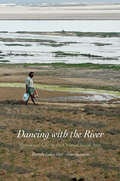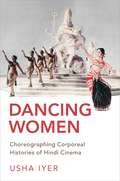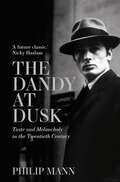- Table View
- List View
Dancing Motherhood (Routledge Series in Equity, Diversity, and Inclusion in Theatre and Performance)
by Ali DuffyDancing Motherhood explores how unique factors about the dance profession impact pregnant women and mothers working in it. Ali Duffy introduces the book by laying a foundation of social and cultural histories and systemic structures and power that shape the issues mothers in dance negotiate today. This book then reveals perspectives from mothers in dance working in areas such as performance, choreography, dance education, administration, and advocacy though survey and interview data. Based on participant responses, recommendations for changes in policy, hiring, evaluation, workplace environment, and other professional and personal practices to better support working mothers in dance are highlighted. Finally, essays from eight working mothers in dance offer intimate, personal stories and guidance geared to mothers, future mothers, policymakers, and colleagues and supervisors of mothers in the dance field. By describing lived experiences and offering suggestions for improved working conditions and advocacy, this book initiates expanded discussion about women in dance and promotes change to positively impact dancing mothers, their employers, and the dance field.
Dancing Motherhood (Routledge Series in Equity, Diversity, and Inclusion in Theatre and Performance)
by Ali DuffyDancing Motherhood explores how unique factors about the dance profession impact pregnant women and mothers working in it. Ali Duffy introduces the book by laying a foundation of social and cultural histories and systemic structures and power that shape the issues mothers in dance negotiate today. This book then reveals perspectives from mothers in dance working in areas such as performance, choreography, dance education, administration, and advocacy though survey and interview data. Based on participant responses, recommendations for changes in policy, hiring, evaluation, workplace environment, and other professional and personal practices to better support working mothers in dance are highlighted. Finally, essays from eight working mothers in dance offer intimate, personal stories and guidance geared to mothers, future mothers, policymakers, and colleagues and supervisors of mothers in the dance field. By describing lived experiences and offering suggestions for improved working conditions and advocacy, this book initiates expanded discussion about women in dance and promotes change to positively impact dancing mothers, their employers, and the dance field.
Dancing Queen und Ghetto Rapper: Die massenmediale Konstruktion des "Anderen". Eine systemtheoretische Analyse der hegemonialen Diskurse über Ethnizität und Geschlecht in populären Musikvideos (Reihe Medienwissenschaft #12)
by Christina SchochEkstatisch tanzende Bikinimädchen, Soft-Pornographie, gewaltverherrlichender Gangster Rap ... Popkultur lebt auch von der Provokation. Musikvideos als wichtiger Bestandteil der Popkultur haben es immer wieder geschafft, in diesem Sinne zu provozieren. Und sie haben es geschafft, daß ehemals Provozierendes heute zum Standardrepertoire massenmedialer Unterhaltungskultur gehört.Der Videoclip als massenmediales, kommerzielles Phänomen hat zum einen eine nicht zu leugnende ökonomische Komponente, zum anderen kann er aber auch das ästhetische Produkt künstlerischer Ambitionen sein. In jedem Fall werden im Musikvideo auf die eine oder andere Weise unterschiedliche kulturelle Diskurse verarbeitet. Diese Arbeit widmet sich beiden Perspektiven, indem sie sowohl die ökonomischen als auch die kulturellen Komponenten von Musikvideos behandelt. Beide Aspekte sind untrennbar miteinander verbunden und müssen aus diesem Grund in eine ganzheitliche Betrachtung des Gegenstandes einbezogen werden. Angesichts der Komplexität und Reichhaltigkeit, welche Musikvideos als kulturwissenschaftliche Forschungsgegenstände bieten, konzentriert sich die Untersuchung auf zwei wesentliche Aspekte der visuellen Darstellungen in Musikclips. Diese Arbeit bietet eine visuelle Analyse der Inszenierung von als „nicht-weiß“ und „nicht-männlich“ markierten Darstellern in Videoclips der Jahre 1979 bis 2003. Die Arbeit basiert auf drei methodischen Herangehensweisen: Der klassischen kommunikations- bzw. medienwissenschaftlichen Inhaltsanalyse auf der quantitativen Ebene, der (mittlerweile auch schon klassischen) kulturwissenschaftlichen Diskursanalyse im Anschluss an Foucault auf der qualitativen Ebene und der Systemtheorie im Anschluss an Luhmann auf der übergeordneten, strukturellen Ebene.
Dancing Revelations: Alvin Ailey's Embodiment of African American Culture
by Thomas F. DeFrantzIn the early 1960s, the Alvin Ailey American Dance Theater was a small, multi-racial company of dancers that performed the works of its founding choreographer and other emerging artists. By the late 1960s, the company had become a well-known African American artistic group closely tied to the Civil Rights struggle. In Dancing Revelations, Thomas DeFrantz chronicles the troupe's journey from a small modern dance company to one of the premier institutions of African American culture. He not only charts this rise to national and international renown, but also contextualizes this progress within the civil rights, women's rights, and gay rights struggles of the late 20th century. DeFrantz examines the most celebrated Ailey dances, including Revelations, drawing on video recordings of Ailey's dances, published interviews, oral histories, and his own interviews with former Ailey company dancers. Through vivid descriptions and beautiful illustrations, DeFrantz reveals the relationship between Ailey's works and African American culture as a whole. He illuminates the dual achievement of Ailey as an artist and as an arts activist committed to developing an African American presence in dance. He also addresses concerns about how dance performance is documented, including issues around spectatorship and the display of sexuality, the relationship of Ailey's dances to civil rights activism, and the establishment and maintenance of a successful, large-scale Black Arts institution. Throughout Dancing Revelations, DeFrantz illustrates how Ailey combined elements of African dance with motifs adapted from blues, jazz, and Broadway to choreograph his dances. By re-interpreting these tropes of black culture in his original and well-received dances, DeFrantz argues that Ailey played a significant role in defining the African American cultural canon in the twentieth century. As the first book to examine the cultural sources and cultural impact of Ailey's work, Dancing Revelations is an important contribution to modern dance history and criticism as well as African-American studies.
Dancing Revelations: Alvin Ailey's Embodiment of African American Culture
by Thomas F. DeFrantzIn the early 1960s, the Alvin Ailey American Dance Theater was a small, multi-racial company of dancers that performed the works of its founding choreographer and other emerging artists. By the late 1960s, the company had become a well-known African American artistic group closely tied to the Civil Rights struggle. In Dancing Revelations, Thomas DeFrantz chronicles the troupe's journey from a small modern dance company to one of the premier institutions of African American culture. He not only charts this rise to national and international renown, but also contextualizes this progress within the civil rights, women's rights, and gay rights struggles of the late 20th century. DeFrantz examines the most celebrated Ailey dances, including Revelations, drawing on video recordings of Ailey's dances, published interviews, oral histories, and his own interviews with former Ailey company dancers. Through vivid descriptions and beautiful illustrations, DeFrantz reveals the relationship between Ailey's works and African American culture as a whole. He illuminates the dual achievement of Ailey as an artist and as an arts activist committed to developing an African American presence in dance. He also addresses concerns about how dance performance is documented, including issues around spectatorship and the display of sexuality, the relationship of Ailey's dances to civil rights activism, and the establishment and maintenance of a successful, large-scale Black Arts institution. Throughout Dancing Revelations, DeFrantz illustrates how Ailey combined elements of African dance with motifs adapted from blues, jazz, and Broadway to choreograph his dances. By re-interpreting these tropes of black culture in his original and well-received dances, DeFrantz argues that Ailey played a significant role in defining the African American cultural canon in the twentieth century. As the first book to examine the cultural sources and cultural impact of Ailey's work, Dancing Revelations is an important contribution to modern dance history and criticism as well as African-American studies.
Dancing the Labyrinth: Spirituality in the Lives of Women
by Maddy Cunningham Jade de SaussureThere is a scarcity of professional literature and research that focuses on women's spiritual development and experiences and how they may differ from those of men. For women, the spiritual is often inner-focused, rather than transcendent; relational, rather than solitary; and interdependent, rather than autonomous. Dancing the Labyrinth integrates knowledge of women's psychological and spiritual development alongside stories of a diverse group of women to examine how spirituality changes over the adult life course; the catalysts for said changes (e.g., the natural aging process or traumatic events); and feminist spirituality, which highlights the importance of relationships (to self, others, and God). While the authors focus on spirituality, they examine the experiences of women who express their spirituality within both traditional and non-traditional paths. The text also includes several chapters that highlight specific clinical interventions professionals can use to implement spirituality into their practice with women. Written in an engaging and accessible style, this book serves as a helpful resource for mental health practitioners, pastoral counselors, spiritual directors, and lay audiences interested in better understanding of the nuances of women's spiritual development and experiences.
Dancing the Labyrinth: Spirituality in the Lives of Women
by Maddy Cunningham Jade de SaussureThere is a scarcity of professional literature and research that focuses on women's spiritual development and experiences and how they may differ from those of men. For women, the spiritual is often inner-focused, rather than transcendent; relational, rather than solitary; and interdependent, rather than autonomous. Dancing the Labyrinth integrates knowledge of women's psychological and spiritual development alongside stories of a diverse group of women to examine how spirituality changes over the adult life course; the catalysts for said changes (e.g., the natural aging process or traumatic events); and feminist spirituality, which highlights the importance of relationships (to self, others, and God). While the authors focus on spirituality, they examine the experiences of women who express their spirituality within both traditional and non-traditional paths. The text also includes several chapters that highlight specific clinical interventions professionals can use to implement spirituality into their practice with women. Written in an engaging and accessible style, this book serves as a helpful resource for mental health practitioners, pastoral counselors, spiritual directors, and lay audiences interested in better understanding of the nuances of women's spiritual development and experiences.
Dancing to the State: Ethnic Compulsions of the Tangsa in Assam
by Meenaxi Barkataki-RuscheweyhCan small indigenous communities survive as distinct cultural entities in northeast India, an area characterized by mind-boggling ethnic, linguistic, and cultural diversity? What are the choices that such minority groups have, and how do they resist further marginalization? Diversity in northeast India is often celebrated and performed. There has been a spate of ethnic festivals in this region in the recent years, but a question remains: Are these activities of ethnic revival signs of increasing agency or proof of their continued marginalization? Situated around the tiny Tangsa community of Assam, this narrative ethnography looks at ethnic marginality and the compulsions imposed on minority communities by the dominant community, state policies, and political borders. The concerns of the Tangsa community through multiple case studies while also reflecting on questions arising from the fact that she belongs to the dominant Assamese In a novel anthropological endeavour, the author portrays community. Unlike a theoretical treatise, the aim in this book is to empower the subjects of study by narrating their life stories and everyday concerns in simple language, thereby addressing a wider audience.
Dancing With Bigotry: Beyond the Politics of Tolerance
by NA NA Donaldo Macedo Lilia I. BartoloméAs the end of the century draws closer, one of the most pressing challenges facing educators in the United States is the specter of an 'ethnic and cultural war' - a code phrase that engenders our society's licentiousness toward racism. In Dancing With Bigotry, Macedo and Bartolomé use examples from the mass media, popular culture, and politics to illustrate the larger situations facing educators and how this type of argument is both ignored in much of the academic research and rhetoric. They also examine why it is essential to take on the sources of 'mass public education.' Academia needs to understand that the popular press and mass media educate more people about issues regarding ethnicity and race than all other sources of education available to U.S. citizens. By shunning the mass media, educators are missing the obvious - more public education is done by the media than by teachers, professors, or anyone else. Dancing with Bigotry sheds light on the ideological mechanisms that shape and maintain the racist social order, while moving the discussion beyond the reductionist binarism of White versus Black racism. Discussing social complexities, including ethnic cleansing, culture wars, hegemony, human sufferings, and intensified xenophobia, Macedo and Bartolomé explain why it is essential that we gain a nuanced understanding of how ideology underlies all social, cultural, and political discourse and actions. This book shows that it is imperative that we appreciate what it means to educate for critical citizenry in the ever-increasing multiracial and multicultural world of the twentieth century.
Dancing with Georges Perec: Embodying Oulipo (ISSN)
by Leslie SatinThis book explores the relationship of the life and work of the remarkable Parisian-Jewish writer Georges Perec (1936–1983) to dance."Dancing" addresses art-making parallels and their personal and sociocultural contexts, including Perec’s childhood loss of his parents in the Holocaust and its repercussions in the significance of the body, everydayness, space, and attention permeating his work. This book, emerging from the author Leslie Satin’s perspective as a dancer and scholar, links Perec’s concerns with those of dance and demonstrates that Perec’s work has implications for dance and how we think about it. Moreover, it is framed as a performative autobiographical enactment of the author's relationship to Perec, periodically linking their written, danced, and imagined lives.This exploration will be of great interest to dancers, dance scholars, and dance students interested in contemporary experimental dance and contemporary dance.
Dancing with Georges Perec: Embodying Oulipo (ISSN)
by Leslie SatinThis book explores the relationship of the life and work of the remarkable Parisian-Jewish writer Georges Perec (1936–1983) to dance."Dancing" addresses art-making parallels and their personal and sociocultural contexts, including Perec’s childhood loss of his parents in the Holocaust and its repercussions in the significance of the body, everydayness, space, and attention permeating his work. This book, emerging from the author Leslie Satin’s perspective as a dancer and scholar, links Perec’s concerns with those of dance and demonstrates that Perec’s work has implications for dance and how we think about it. Moreover, it is framed as a performative autobiographical enactment of the author's relationship to Perec, periodically linking their written, danced, and imagined lives.This exploration will be of great interest to dancers, dance scholars, and dance students interested in contemporary experimental dance and contemporary dance.
Dancing with Iris: The Philosophy of Iris Marion Young (Studies in Feminist Philosophy)
by Ann Ferguson Mechthild NagelIris Marion Young was a world-renowned feminist moral and political philosopher whose many books and articles spanned more than three decades. She explored issues of social justice and oppression theory, the phenomenology of women's bodies, deliberative democracy and questions of terrorism, violence, international law and the role of the national security state. Her works have been of great interest to those both in the analytic and Continental philosophical tradition, and her roots range from critical theory (Habermas and Marcuse), and phenomenology (Beauvoir and Merleau Ponty) to poststructural psychoanalytic feminism (Kristeva and Ingaray). This anthology of writings aims to carry on the fruitful lines of thought she created and contains works by both well-known and younger authors who explore and engage critically with aspects of her work. The essays include personal remembrances as well as a last interview with Young about her work. The essays are organized into topic areas that are of interest to students in advanced undergraduate and graduate courses in ethics, feminist theory, and political philosophy.
Dancing with the Devil: Why Bad Feelings Make Life Good
by Krista K. ThomasonJust as a garden needs worms, we need bad feelings.... We tend to think about bad feelings--feelings like anger, envy, spite, and contempt--as the weeds in life's garden. You may not be able to get rid of them completely, but you're supposed to battle them as best you can. The best garden is one with no weeds. The best life is one with no bad feelings. But this isn't quite right, according to philosopher Krista K. Thomason. Bad feelings are the worms, not the weeds. They're just below the surface, and we like to pretend they aren't there, but they serve an important purpose. Worms are just as much a part of the garden as the flowers, and their presence means your garden is thriving. Gardens aren't better off without their worms, and neither are we. The trick is learning how to enjoy our gardens, worms and all. Thomason draws on insights from the history of philosophy to show what we've gotten wrong about bad feelings and to show readers how we can live better with them. There is nothing wrong with negative emotions per se. Their bad reputation is undeserved. Negative emotions are expressions of self-love--not egoism or selfishness, but the felt attachment to ourselves and to our lives. We feel negative emotions because our lives matter to us. After explaining this, Thomason helps us look at individual bad feelings: anger, envy and jealousy, spite and Schadenfreude, and contempt. As she demonstrates in this tour of negative emotions, these feelings are valuable parts of our attachment to our lives. We don't have to battle negative emotions or "channel" them into something productive. Bad feelings aren't obstacles to a good life; they are part of what makes life meaningful.
Dancing with the Devil: Why Bad Feelings Make Life Good
by Krista K. ThomasonJust as a garden needs worms, we need bad feelings.... We tend to think about bad feelings--feelings like anger, envy, spite, and contempt--as the weeds in life's garden. You may not be able to get rid of them completely, but you're supposed to battle them as best you can. The best garden is one with no weeds. The best life is one with no bad feelings. But this isn't quite right, according to philosopher Krista K. Thomason. Bad feelings are the worms, not the weeds. They're just below the surface, and we like to pretend they aren't there, but they serve an important purpose. Worms are just as much a part of the garden as the flowers, and their presence means your garden is thriving. Gardens aren't better off without their worms, and neither are we. The trick is learning how to enjoy our gardens, worms and all. Thomason draws on insights from the history of philosophy to show what we've gotten wrong about bad feelings and to show readers how we can live better with them. There is nothing wrong with negative emotions per se. Their bad reputation is undeserved. Negative emotions are expressions of self-love--not egoism or selfishness, but the felt attachment to ourselves and to our lives. We feel negative emotions because our lives matter to us. After explaining this, Thomason helps us look at individual bad feelings: anger, envy and jealousy, spite and Schadenfreude, and contempt. As she demonstrates in this tour of negative emotions, these feelings are valuable parts of our attachment to our lives. We don't have to battle negative emotions or "channel" them into something productive. Bad feelings aren't obstacles to a good life; they are part of what makes life meaningful.
Dancing with the Doctor: Dimensions of Gender in the Doctor Who Universe (Who Watching)
by Lorna JowettWidespread conversations and criticisms continue about the ways in which Doctor Who represents gender. Dancing with the Doctor, the first book on the Doctor Who universe to take gender as its focus, examines both the successful revival of the series since 2005 and its spin-off series, Torchwood and The Sarah Jane Adventures. Lorna Jowett delves into the distinctive stories and characters, including the Doctors themselves, their female and male companions, Captain Jack Harkness, Missy, Sarah Jane and her young comrades. She considers the showrunners, directors, producers and writers and the problems this flagship science fiction series has had in offering alternative gender models. Constructions of masculinity, the author function, and how gender intersects with the other facets of identity, race, ethnicity and age, are just some of the areas explored in this accessible and wide-ranging re-view of these hotly debated elements of the successful BBC franchise.
Dancing with the River: People and Life on the Chars of South Asia (Yale Agrarian Studies Series)
by Kuntala Lahiri-Dutt Gopa SamantaWith this book Kuntala Lahiri-Dutt and Gopa Samanta offer an intimate glimpse into the microcosmic world of "hybrid landscapes.” Focusing on chars-the part-land, part-water, low-lying sandy masses that exist within the riverbeds in the floodplains of lower Bengal-the authors show how, both as real-life examples and as metaphors, chars straddle the conventional categories of land and water, and how people who live on them fluctuate between legitimacy and illegitimacy. The result, a study of human habitation in the nebulous space between land and water, charts a new way of thinking about land, people, and people's ways of life.
Dancing Women: Choreographing Corporeal Histories of Hindi Cinema
by Usha IyerDancing Women: Choreographing Corporeal Histories of Hindi Cinema, an ambitious study of two of South Asia's most popular cultural forms cinema and dance historicizes and theorizes the material and cultural production of film dance, a staple attraction of popular Hindi cinema. It explores how the dynamic figurations of the body wrought by cinematic dance forms from the 1930s to the 1990s produce unique constructions of gender, sexuality, stardom, and spectacle. By charting discursive shifts through figurations of dancer-actresses, their publicly performed movements, private training, and the cinematic and extra-diegetic narratives woven around their dancing bodies, the book considers the "women's question" via new mobilities corpo-realized by dancing women. Some of the central figures animating this corporeal history are Azurie, Sadhona Bose, Vyjayanthimala, Helen, Waheeda Rehman, Madhuri Dixit, and Saroj Khan, whose performance histories fold and intersect with those of other dancing women, including devadasis and tawaifs, Eurasian actresses, oriental dancers, vamps, choreographers, and backup dancers. Through a material history of the labor of producing on-screen dance, theoretical frameworks that emphasize collaboration, such as the "choreomusicking body" and "dance musicalization," aesthetic approaches to embodiment drawing on treatises like the Natya Sastra and the Abhinaya Darpana, and formal analyses of cine-choreographic "techno-spectacles," Dancing Women offers a variegated, textured history of cinema, dance, and music. Tracing the gestural genealogies of film dance produces a very different narrative of Bombay cinema, and indeed of South Asian cultural modernities, by way of a corporeal history co-choreographed by a network of remarkable dancing women.
Dancing Women: Choreographing Corporeal Histories of Hindi Cinema
by Usha IyerDancing Women: Choreographing Corporeal Histories of Hindi Cinema, an ambitious study of two of South Asia's most popular cultural forms cinema and dance historicizes and theorizes the material and cultural production of film dance, a staple attraction of popular Hindi cinema. It explores how the dynamic figurations of the body wrought by cinematic dance forms from the 1930s to the 1990s produce unique constructions of gender, sexuality, stardom, and spectacle. By charting discursive shifts through figurations of dancer-actresses, their publicly performed movements, private training, and the cinematic and extra-diegetic narratives woven around their dancing bodies, the book considers the "women's question" via new mobilities corpo-realized by dancing women. Some of the central figures animating this corporeal history are Azurie, Sadhona Bose, Vyjayanthimala, Helen, Waheeda Rehman, Madhuri Dixit, and Saroj Khan, whose performance histories fold and intersect with those of other dancing women, including devadasis and tawaifs, Eurasian actresses, oriental dancers, vamps, choreographers, and backup dancers. Through a material history of the labor of producing on-screen dance, theoretical frameworks that emphasize collaboration, such as the "choreomusicking body" and "dance musicalization," aesthetic approaches to embodiment drawing on treatises like the Natya Sastra and the Abhinaya Darpana, and formal analyses of cine-choreographic "techno-spectacles," Dancing Women offers a variegated, textured history of cinema, dance, and music. Tracing the gestural genealogies of film dance produces a very different narrative of Bombay cinema, and indeed of South Asian cultural modernities, by way of a corporeal history co-choreographed by a network of remarkable dancing women.
Dancing Youth: Hip Hop and Gender in Late Socialist Vietnam (Global Studies)
by Sandra KurfürstBreaking, popping, locking, waacking, and hip-hop dance are practiced widely in contemporary Vietnam. Considering the dance practices in the larger context of post-socialist transformation, urban restructuring, and changing gender relations, Sandra Kurfürst examines youth's aspirations and desires embodied in dance. Drawing on a rich and diverse range of qualitative data, including interviews, sensory and digital ethnography, she shows how dancers confront social and gender norms while following their passion. As a contribution to area and global studies, the book illuminates the translocal spatialities of hip hop, produced through the circulation of objects and the movement of people.
The Dandy at Dusk
by Philip MannPhilip Mann chronicles the relationship of dandyism and the emerging cultural landscape of modernity via portraits of Regency England's Beau Brummel – the first dandy – and six twentieth-century figures: Austrian architect Adolf Loos, the Duke of Windsor, neo-Edwardian courtier Bunny Roger, writer and raconteur Quentin Crisp, French film producer Jean-Pierre Melville, and New German Cinema enfant terrible and inverted dandy Rainer Werner Fassbinder. He blends memorable anecdotes with acute analysis to explore their style, identity and influence and interweaves their stories with an entertaining history of tailoring and men's fashion. The Dandy at Dusk contextualizes the relationship between dandyism, decadence and modernism, against the background of a century punctuated by global conflict and social upheaval.
Dandyism and Transcultural Modernity: The Dandy, the Flaneur, and the Translator in 1930s Shanghai, Tokyo, and Paris (Academia Sinica on East Asia)
by Hsiao-yen PengThis book views the Neo-Sensation mode of writing as a traveling genre, or style, that originated in France, moved on to Japan, and then to China. The author contends that modernity is possible only on "the transcultural site"—transcultural in the sense of breaking the divide between past and present, elite and popular, national and regional, male and female, literary and non-literary, inside and outside. To illustrate the concept of transcultural modernity, three icons are highlighted on the transcultural site: the dandy, the flaneur, and the translator. Mere flaneurs and flaneurses simply float with the tide of heterogeneous information on the transcultural site, whereas the dandy/flaneur and the cultural translator, propellers of modernity, manage to bring about transformative creation. Their performance marks the essence of transcultural modernity: the self-consciousness of working on the threshold, always testing the limits of boundaries and tempted to go beyond them. To develop the concept of dandyism—the quintessence of transcultural modernity—the Neo-Sensation gender triad formed by the dandy, the modern girl, and the modern boy is laid out. Writers discussed include Liu Na’ou, a Shanghai dandy par excellence from Taiwan, Paul Morand, who looked upon Coco Chanel the female dandy as his perfect other self, and Yokomitsu Riichi, who developed the theory of Neo-Sensation from Kant’s the-thing-in-itself.
Dandyism and Transcultural Modernity: The Dandy, the Flaneur, and the Translator in 1930s Shanghai, Tokyo, and Paris (Academia Sinica on East Asia)
by Hsiao-yen PengThis book views the Neo-Sensation mode of writing as a traveling genre, or style, that originated in France, moved on to Japan, and then to China. The author contends that modernity is possible only on "the transcultural site"—transcultural in the sense of breaking the divide between past and present, elite and popular, national and regional, male and female, literary and non-literary, inside and outside. To illustrate the concept of transcultural modernity, three icons are highlighted on the transcultural site: the dandy, the flaneur, and the translator. Mere flaneurs and flaneurses simply float with the tide of heterogeneous information on the transcultural site, whereas the dandy/flaneur and the cultural translator, propellers of modernity, manage to bring about transformative creation. Their performance marks the essence of transcultural modernity: the self-consciousness of working on the threshold, always testing the limits of boundaries and tempted to go beyond them. To develop the concept of dandyism—the quintessence of transcultural modernity—the Neo-Sensation gender triad formed by the dandy, the modern girl, and the modern boy is laid out. Writers discussed include Liu Na’ou, a Shanghai dandy par excellence from Taiwan, Paul Morand, who looked upon Coco Chanel the female dandy as his perfect other self, and Yokomitsu Riichi, who developed the theory of Neo-Sensation from Kant’s the-thing-in-itself.
Danger, Development and Legitimacy in East Asian Maritime Politics: Securing the Seas, Securing the State (Asia's Transformations)
by Christian WirthGrounded in extensive empirical research, Danger, Development and Legitimacy in East Asian Maritime Politics addresses the major issues of geopolitics in the region that have been and will continue to shape the international politics of the Asia-Pacific for years to come. Covering the nation-states of China, Japan and South Korea, it includes an examination of the key island disputes, as well as analysis of the North Korea–South Korea clashes in the Yellow Sea, controversies in Japan’s relations with both Koreas and the so-called ‘history disputes’, including recognition of World War II atrocities across the region. In doing so, this book explores a range of themes from the ecological environment to the globalized nature of shipping and therein links the East Asian maritime sphere directly to the dynamics and developments in the domestic politics of each country. Thus, it serves to demonstrate how several controversial debates in the international politics of the Asia-Pacific are ultimately and inextricably intertwined. A timely contribution that furthers our understanding of contemporary politics of the Asia-Pacific, this book will be of great interest to students and scholars of Asian politics, international relations and the Asia-Pacific region in general.
Danger, Development and Legitimacy in East Asian Maritime Politics: Securing the Seas, Securing the State (Asia's Transformations)
by Christian WirthGrounded in extensive empirical research, Danger, Development and Legitimacy in East Asian Maritime Politics addresses the major issues of geopolitics in the region that have been and will continue to shape the international politics of the Asia-Pacific for years to come. Covering the nation-states of China, Japan and South Korea, it includes an examination of the key island disputes, as well as analysis of the North Korea–South Korea clashes in the Yellow Sea, controversies in Japan’s relations with both Koreas and the so-called ‘history disputes’, including recognition of World War II atrocities across the region. In doing so, this book explores a range of themes from the ecological environment to the globalized nature of shipping and therein links the East Asian maritime sphere directly to the dynamics and developments in the domestic politics of each country. Thus, it serves to demonstrate how several controversial debates in the international politics of the Asia-Pacific are ultimately and inextricably intertwined. A timely contribution that furthers our understanding of contemporary politics of the Asia-Pacific, this book will be of great interest to students and scholars of Asian politics, international relations and the Asia-Pacific region in general.
Danger in Police Culture: Perspectives from South Africa
by Gráinne PerkinsDanger in Police Culture: Perspectives from South Africa offers a fresh perspective on how officers understand, interpret and construct danger. With unique insight from working with uniformed and detective police, the author breaks new ground as the first researcher to work alongside a Tactical Response Team in South Africa. Through ethnographic research in South Africa, Perkins explores the lived experiences of police navigating danger and death. Reframing the question of what makes policing dangerous, the author employs a theoretical framework as a prism, illuminating ambiguous ideas shaping perceptions of danger in police culture. A vivid portrayal of how danger is materialized through risk reduction strategies and artefacts, dramatized through memorialization and normalized in daily police practices, Perkins concludes by reflecting on policy developments aimed at addressing the understanding and influence of danger in contemporary policing. Underscoring the need to reconsider the concept of danger in policing, this is a much-needed assessment of its understanding and impact on contemporary police work. In support of the Perkins Síochána Scholarship, the author’s proceeds from the sale of this book will be used to fund the continuing development of South African graduate students in Criminal Justice and Criminology studies in the Global South.
